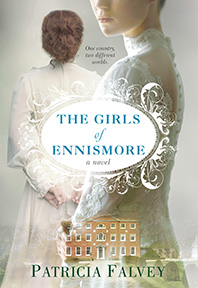THE GIRLS OF ENNISMORE
By Patricia Falvey
Published in March 2017 by Kensington Publishing Corp.
Reviewed by Kirsche Romo
In her historical novel The Girls of Ennismore, Patricia Falvey transports us to early twentieth-century Ireland, where class and circumstance dictate all aspects of daily life. An unexpected and unlikely friendship between two young girls undermines society’s expectations and the presumed entitlement of the Irish gentry.
When eight-year-old Rosie Killeen is summoned to assist the servants at the large Irish estate of Ennismore to entertain the Queen of England. She helps the landowner’s daughter, Victoria Bell, save her toy boat that had drifted into a pond. Victoria is desperate for a playmate and convinces her father to allow Rosie to attend daily lessons with her, although against the wishes of her aristocratic mother and aunt.
For years, Rosie and Victoria study together and become close friends, even including Victoria’s brother Valentine into their friendship circle. But as the time nears for Victoria to make her debut into society, the boundary between the classes once again dictates what is expected of each woman. Will the two be able to maintain their close friendship when once again their worlds become so very different?
“Throughout the autumn of 1910, an unforgiving rain poured down upon the land as if attempting to wash away the sins of history that still lingered there.”
When Bridie, Rosie’s sister, becomes ill and can’t perform her duties of scullery maid at Ennismore, Rosie must swallow her pride and take her sister’s place as a servant for the Bell family or risk losing the wages her own family so desperately needs. But because of her unusual situation, she is neither accepted by the Bell family nor the servants of the estate.
“The damp fog pressed in around her like a prison from which there could be no escape.”
After years pass, Victoria returns to Ennismore, longing for the company of her old friend, but Rosie has ventured to live in Dublin with her sister Bridie. The conditions Rosie finds in Dublin shock her, and after unsuccessfully searching for a job, she turns to Victoria’s family in desperation, asking for their help to survive the poverty of Dublin’s working class.
“Out on the street, rivers of humanity assaulted her. . . Crowds rushed past her – mothers with babies in shawls, rough men, some of them unsteady on their feet, and young girls her own age in cheap, gaudy clothes.”
Both Rosie and Victoria fall into forbidden love. Their lives are laced with uncertainty and scandal, and their devotion is tested by the expectations of the aristocracy and the beginning of the Irish revolution in 1916.
“The seeds of discord sown throughout the summer ripened and spread to every corner of Ennismore. Suspicion, anger, and resentment permeated every conversation. Food spoiled and milk turned sour at alarming rates. Even the birds seemed to cease their chatter. And while the weather was mild, a chill that would not lift clung to the house.”
Will Rosie and Victoria each be able to accomplish the difficult tasks before them? And will they be able to bridge the divide between the Irish aristocracy and the working class that had been the norm for centuries? How much will each woman give up to satisfy their passions, and to make the world a better place?
Patricia Falvey deftly captures the tension between the Irish gentry and the working class in the early twentieth-century. She expertly portrays each character’s humanity, emphasizing the need for all people to be treated with dignity and respect, regardless of station or income. The Girls of Ennismore is a wonderful slice of history which forces us to consider our commonalities, and how we each fit into a world of differences. For readers wanting to explore the social history of early twentieth-century Ireland and to escape into the private lives of the wealthy, the poor, and those in-between, I recommend The Girls of Ennismore.
—
K.L. Romo writes about life on the fringe: teetering dangerously on the edge is more interesting than standing safely in the middle. She is passionate about women’s issues, loves noisy clocks and fuzzy blankets, but HATES the word normal. Her historical novel, Life Before, is about two women separated by a century who discover they’ve shared a soul. Web: KLRomo.com or @klromo.










